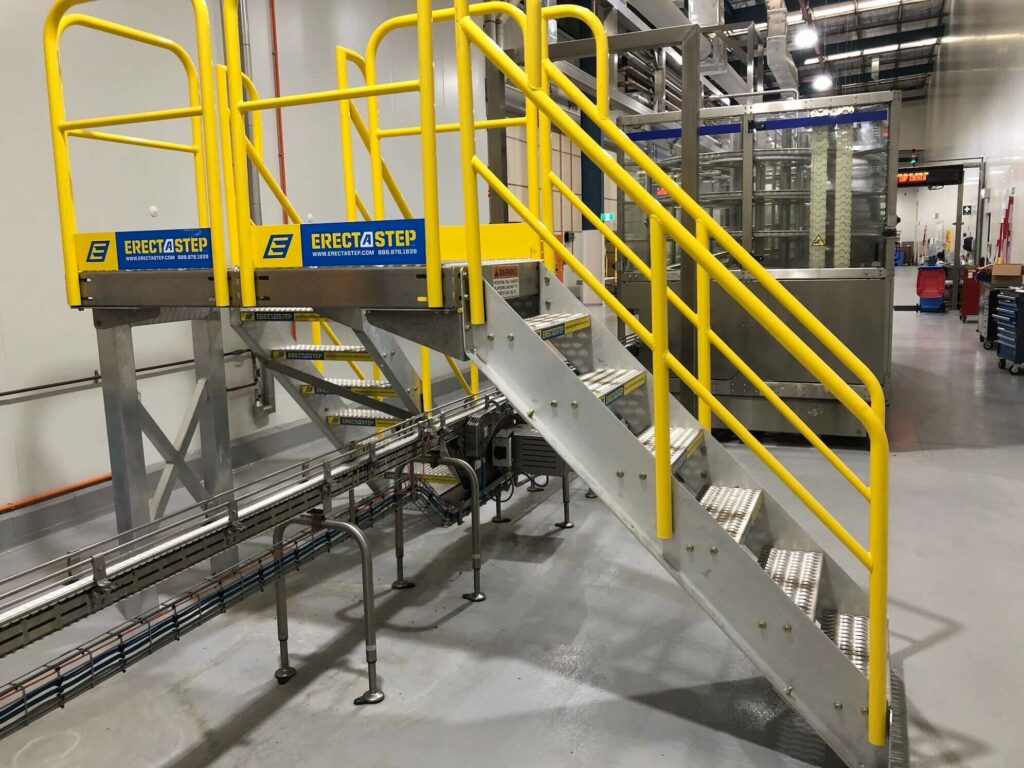Get a quote, configure a custom stair or ask a question. We're here to help!
Australian Food Supplier Optimizes Conveyor System with Crossover Platform Stairs
View All Industrial%20Stairs InstallationsConveyor ErectaStep Crossover stair installation with a platform
Conveyor systems are an integral part of modern food manufacturing. Manufacturers can produce large quantities of food quickly and efficiently by ‘conveyorizing’ food production. In addition, conveyor systems help to reduce labor costs by automating many of the tasks associated with food production. Without conveyor systems, food manufacturers would be forced to rely on slower and cumbersome food production methods, resulting in higher costs and less efficiency.
- Speed up production: Conveyor belts can speed up the process of moving food from one point to another, which means less time between when the food is made and when it’s eaten.
- Reduce labor costs: With conveyor belts doing the hard work, you need fewer people on staff to oversee things, reducing your overall labor costs.
- Avoid accidents caused by human errors: Streamlined food processing reduces the possibility of human errors causing accidents. We can create safer food manufacturing by reducing the potential for error.
- Increased hygiene: Because human hands never touch the food, it’s far less likely to become contaminated and cause food poisoning.
- More consistent product: By using conveyor belts in your production line, you can ensure that each piece of food is made exactly the same way every time, giving your customers consistently high-quality products.
Conveyor systems have evolved greatly since their early inception in the late 1800s. Today’s conveyor systems are more versatile, efficient, and cost-effective than ever. Technological advances allow food manufacturers to customize conveyor systems to meet customers’ needs. For example, facilities can specify how far materials need to be moved and at what speed they need to be transported.
By moving goods from one location to another, conveyor systems help to keep production lines moving smoothly. However, conveyor systems can also pose a safety hazard to workers if they are not properly used. One of the main dangers of conveyor systems is that they can prevent workers from moving freely around the factory floor. Workers entangled in a conveyor belt could be seriously injured or even killed. As a result, employers need to train workers to use conveyor systems properly and safely. Work platforms and conveyor systems can help improve workplace productivity and safety when used correctly.
Conveyor systems are an efficient way to move goods from one point to another; however, they can also create obstacles for workers who need to cross from one side to the other. Crossover stairs can be a component inside a conveyor system specifically designed to allow workers to safely and easily cross conveyor belts. By installing metal stairs over the conveyor system, businesses can optimize worker paths and improve safety in areas where conveyor systems are present.
Metal work platforms are a great solution in providing access to all sides of food manufacturing. They are specifically designed to support the weight of workers crossing conveyor systems. Additionally, when made of aluminum, they are much more resistant to rust. In the food manufacturing industry, preventing corrosion is essential. Factory floors can be extremely corrosive because of occasional water seepage and high moisture content. Turning a blind eye to rust can lead to multiple problems, including equipment failure and food product contamination.
That’s why protecting your factory floor from corrosion is important. Several ways to do this include regular maintenance and powder-coated paint to slow it down. Taking these steps can avoid potential problems and keep your food manufacturing operation running smoothly.
In addition, food manufacturers can use crossover stairs to connect different conveyor belts at different heights, making it easy for workers to access all areas of the conveyor system. Hence, by installing crossover stairs, businesses that use conveyor systems can benefit from improved efficiency and safer working conditions.
Work platforms were bulky and inflexibly designed in the past, making them difficult to install and customize. However, modern work platforms are now made of modular stair parts that technicians can easily assemble to fit various needs. Manufacturers can easily install these access platforms across conveyor belts and change their directions and locations over time without compromising the durability and functionality of these equipment. As a result, work platforms have become much more versatile and user-friendly, making them an essential part of any factory or warehouse.
Coincidentally, work platforms complement your conveyor system as they can help make your work area smarter and your employees much safer. How could this be so, you ask? Well, work platforms offer an ergonomic space for employees to stand while working and provide an easier way for them to access the conveyor system parts that need attention most, improving worker productivity and reducing the likelihood of dangerous accidents occurring.
But that’s not all work platforms do for conveyor systems! They also promote better organization by allowing worker tools and materials to be close at hand rather than strewn about the work area where they’re more likely to get lost or damaged. And when it comes time for maintenance or repairs, work platforms give your team a stable, level surface to work on instead of balancing fall protection on the moving conveyor belt itself.
As conveyor systems have become increasingly commonplace in food manufacturing, they have helped to create a more efficient and cost-effective industry. Conveyor systems continue to play a vital role in the modern food manufacturing process. Investing in a few work platforms can level the manufacturing process up. It is a wise decision that can magnify the benefits of your conveyor systems with additional dividends in increased productivity, safety, and efficiency.









